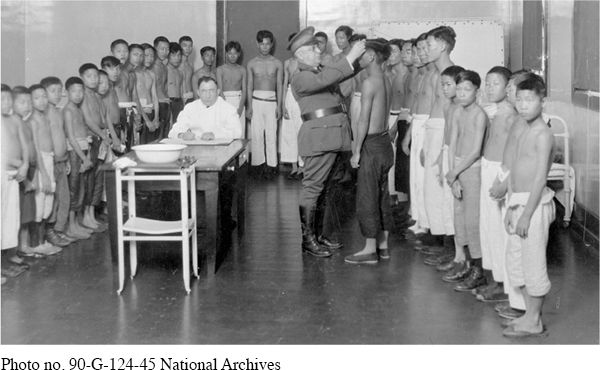Immigrants Arrive from Many Lands
Immigration to the United States was part of a worldwide phenomenon. In addition to the United States, European immigrants also journeyed to other countries in the Western Hemisphere, especially Canada, Argentina, Brazil, and Cuba. Others left China, Japan, and India and migrated to Southeast Asia and Hawaii. From England and Ireland, migrants ventured to other parts of the British empire. As with those who came to the United States, these immigrants left their homelands to find new job opportunities or to obtain land to start their own farms. In countries like Australia, New Zealand, and South Africa, white settlers often pushed aside native peoples to make communities for themselves. Whereas most immigrants chose to relocate voluntarily, some made the move bound by labor contracts that limited their movement during the terms of the agreement. Chinese, Mexican, and Italian workers made up a large portion of this group.
The late nineteenth century saw a shift in the country of origin of immigrants to the United States: Instead of coming from northern and western Europe, many now came from southern and eastern European countries, most notably Italy, Greece, Austria-Hungary, Poland, and Russia. Most of those settling on American shores after 1880 were Catholic or Jewish and hardly knew a word of English. They tended to be even poorer than immigrants who had arrived before them, coming mainly from rural areas and lacking suitable skills for a rapidly expanding industrial society. Even after relocating to a new land and a new society, such immigrants struggled to break patterns of poverty that were, in many cases, centuries in the making.
Immigrants came from other parts of the world as well. From 1860 to 1924, some 450,000 Mexicans migrated to the U.S. Southwest. Many traveled to El Paso, Texas, near the Mexican border, and from there hopped aboard one of three railroad lines to jobs on farms and in mines, mills, and construction. Cubans, Spaniards, and Bahamians traveled to the Florida cities of Key West and Tampa, where they established and worked in cigar factories. Although Congress excluded Chinese immigration after 1882, it did not close the door to migrants from Japan. Unlike the Chinese, the Japanese had not competed with white workers for jobs on railroad and other construction projects. Moreover, Japan was a major world power in the late nineteenth century and held American respect by defeating Russia in the Russo-Japanese War of 1904–1905. Some 260,000 Japanese arrived in the United States during the first two decades of the twentieth century. Many of them settled on the West Coast, where they worked as farm laborers and gardeners and established businesses catering to a Japanese clientele. Nevertheless, Japanese immigrants were considered part of an inferior “yellow race” and encountered discrimination in their West Coast settlements.
Despite the 1882 Chinese Exclusion Act, tens of thousands of Chinese attempted to immigrate, many claiming to be family members of those already in the country. Some first went to Canada or Mexico, but very few managed to cross over the border illegally. In 1910 the government established an immigration station at Angel Island in San Francisco Bay. In contrast to Ellis Island, Angel Island served mainly as a detention center where Chinese immigrants were imprisoned for months, even years, while they sought to prove their eligibility to enter the United States. Nevertheless, over the next thirty years, some 50,000 Chinese successfully passed through Angel Island.

This wave of immigration changed the composition of the American population. By 1910 one-third of the population was foreign-born or had at least one parent who came from abroad. Foreigners and their children made up more than three-quarters of the population of New York City, Detroit, Chicago, Milwaukee, Cleveland, Minneapolis, and San Francisco. Immigration, though not as extensive in the South as in the North, also altered the character of southern cities. About one-third of the population of Tampa, Miami, and New Orleans consisted of foreigners and their descendants. The borderland states of Texas, New Mexico, Arizona, and southern California contained similar percentages of immigrants, most of whom came from Mexico.
These immigrants came to the United States largely for economic, political, and religious reasons. Nearly all were poor and expected to find ways to make money in America. U.S. railroads and steamship companies advertised in Europe and recruited passengers by emphasizing economic opportunities in the United States. Early immigrants wrote to relatives back home extolling the virtues of what they had found, perhaps exaggerating their success.
The importance of economic incentives in luring immigrants is underscored by the fact that millions returned to their home countries after they had earned sufficient money. Of the more than 27 million immigrants from 1875 to 1919, 11 million returned home (Table 18.1). Immigrants facing religious or political persecution in their homeland, like Beryl Lassin, were the least likely to return.
| Year | Arrivals | Departures | Percentage of Departures to Arrivals |
| 1875–1879 | 956,000 | 431,000 | 45% |
| 1880–1884 | 3,210,000 | 327,000 | 10% |
| 1885–1889 | 2,341,000 | 638,000 | 27% |
| 1890–1894 | 2,590,000 | 838,000 | 32% |
| 1895–1899 | 1,493,000 | 766,000 | 51% |
| 1900–1904 | 3,575,000 | 1,454,000 | 41% |
| 1905–1909 | 5,533,000 | 2,653,000 | 48% |
| 1910–1914 | 6,075,000 | 2,759,000 | 45% |
Exploring American HistoriesPrinted Page 586
Exploring American Histories Value EditionPrinted Page 432
Chapter Timeline